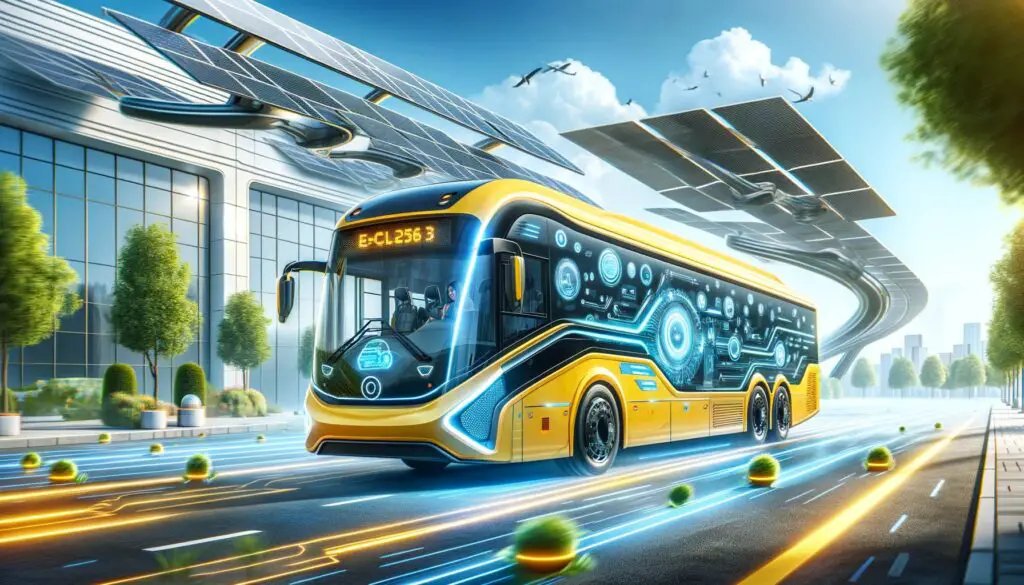In recent years, the transportation industry has been undergoing a significant transformation towards sustainability and environmental responsibility. Among the many innovations, the rise of electric school buses has emerged as a game-changer. In this comprehensive article, we delve into the various facets of electric school buses and their potential to contribute to a cleaner and more sustainable future for the United States.
Introduction
The Rise of Electric School Buses
Electric school buses are revolutionizing the way we transport our children to and from school. These buses are powered by electricity, eliminating the need for traditional fossil fuels, and offering a more environmentally friendly solution. As the world grapples with the consequences of climate change, the adoption of electric school buses represents a critical step towards reducing greenhouse gas emissions and improving air quality.
Potential for Electric Buses to Contribute to a Clean Energy Future
One of the key benefits of electric school buses lies in their potential to contribute to a cleaner and more sustainable energy future. By leveraging renewable energy sources to charge these buses, we can reduce our reliance on non-renewable energy and decrease our carbon footprint. Electric buses can serve as a cornerstone for building a clean energy ecosystem that benefits both the environment and society as a whole.
Significance of Electric School Buses in the United States
The adoption of electric school buses is not just a local trend but a national imperative. With the United States facing growing concerns about air quality, climate change, and energy security, electric school buses have emerged as a solution that addresses multiple challenges simultaneously. Their significance extends beyond the educational sector, impacting the broader transportation and energy landscape.
The Current State of Electric School Buses
Percentage of Electric School Buses in Operation
The electric school bus market is rapidly growing, with an increasing number of school districts across the country transitioning to electric-powered fleets. This shift is driven by the desire to reduce emissions, save on operational costs, and provide a cleaner and safer mode of transportation for students.
Advances in Electric Bus Technology
Recent advancements in electric bus technology have significantly improved their performance and range. Modern electric school buses are equipped with cutting-edge battery technology, regenerative braking systems, and efficient charging infrastructure. These innovations have made electric buses a viable and cost-effective option for school districts.
Federal Funding Through the Infrastructure Investment and Jobs Act
The recent passage of the Infrastructure Investment and Jobs Act has provided a significant boost to the electric school bus industry. This legislation allocates substantial funding to support the expansion of electric bus fleets, charging infrastructure, and related research and development initiatives. It signifies the government’s commitment to advancing clean and sustainable transportation.
Environmental and Health Benefits
Improving Children’s Health
The transition to electric school buses directly impacts the health and well-being of students. By eliminating harmful emissions from diesel buses, electric buses provide a cleaner and healthier environment for children to travel in. Reduced exposure to air pollutants can lead to fewer respiratory issues and improved overall health among students.
Reducing Air Pollution in Communities
Electric school buses also play a vital role in reducing air pollution in the communities they serve. Traditional diesel buses emit pollutants such as particulate matter and nitrogen oxides, contributing to poor air quality. Electric buses produce zero tailpipe emissions, thus helping to mitigate air pollution in neighborhoods and around schools.
Alleviating the Burden on Underserved Communities
Underserved communities often bear the brunt of pollution and environmental degradation. Electric school buses can help alleviate this burden by reducing air pollution in these areas. By prioritizing electric bus adoption in underserved communities, we can address environmental justice issues and create a more equitable transportation system.
Vehicle-to-Grid (V2G) Technology
Explanation of V2G Technology
Vehicle-to-Grid (V2G) technology is a groundbreaking concept that allows electric school buses to not only consume electricity but also feed surplus energy back into the grid. This two-way interaction transforms electric buses into mobile energy assets, enhancing grid stability and resilience.
How Electric School Buses Can Stabilize the Grid
Electric school buses equipped with V2G technology can stabilize the grid by providing grid operators with additional sources of electricity during peak demand periods. This flexibility is invaluable in preventing blackouts, improving grid reliability, and facilitating the integration of renewable energy sources.
Potential Revenue Generation for School Districts
V2G technology also opens up new revenue streams for school districts. By participating in demand response programs and selling excess electricity to the grid, school districts can generate income that offsets the initial costs of electric bus adoption and infrastructure investment.
Energy Storage Potential
School Buses as Sources of Energy Storage
Electric school buses have the unique capability of serving as energy storage units. During periods of low demand, these buses can store excess electricity, which can be discharged during peak demand, effectively acting as a mobile energy reservoir.
Contribution to the National Electricity Capacity
The aggregated energy storage capacity of electric school buses nationwide has the potential to significantly augment the country’s electricity capacity. This capacity can be harnessed to meet peak demand, reducing the need for costly infrastructure upgrades.
Reduction in Greenhouse Gas Emissions
The use of electric school buses as energy storage devices also contributes to a reduction in greenhouse gas emissions. By utilizing stored energy during peak hours, power plants can operate more efficiently, leading to lower carbon emissions.
Benefits for Vehicle Owners and Utilities
Reduction in Greenhouse Gas Emissions
Electric school buses offer tangible benefits to vehicle owners in terms of reduced operating costs and maintenance. Electric motors are simpler and require less maintenance compared to their diesel counterparts, resulting in long-term savings.
Avoidance of Emissions from Charging
Charging electric buses during off-peak hours further reduces greenhouse gas emissions. By leveraging electricity from clean energy sources, the environmental impact of electric bus charging is minimized.
Reduction in CO2 Emissions from Peak Shaving
Electric school buses with V2G capabilities can engage in peak shaving, which involves reducing electricity consumption during high-demand periods. This not only lowers electricity costs but also decreases CO2 emissions associated with peak power generation.
Energy Services Provided by V2G
Demand Response and Peak Shaving
Electric buses can actively participate in demand response programs, helping utilities manage electricity demand during peak hours. This flexibility contributes to grid stability and prevents costly blackouts.
Energy Arbitrage
Energy arbitrage involves buying electricity during low-demand periods and selling it back to the grid during high-demand periods at a higher price. Electric school buses can engage in this practice, offering financial benefits to both school districts and utilities.
Economic Viability of V2G Systems
The economic viability of V2G systems is increasingly evident, with the potential for significant cost savings and revenue generation. School districts and utilities alike stand to benefit from the financial advantages of V2G technology.
Backup Power During Emergencies
Electric School Buses as Temporary Power Sources
During emergencies, such as natural disasters or grid failures, electric school buses equipped with V2G technology can serve as temporary power sources. These buses can provide critical electricity to emergency shelters, hospitals, and essential infrastructure, enhancing emergency management efforts.
Support for Emergency Management Efforts
The availability of backup power from electric school buses enhances the resilience of communities during emergencies. It ensures that essential services can continue to operate, saving lives and minimizing disruption.
Providing Power to Critical Infrastructure
Electric buses can play a crucial role in providing power to critical infrastructure, including communication centers, water treatment plants, and emergency response facilities. This reliability is invaluable in safeguarding public safety.
Financial Benefits
Lower Operating Costs with Electric Buses
Electric buses offer lower operating costs compared to diesel counterparts. Reduced fuel expenses, fewer maintenance requirements, and longer lifespan make electric school buses a financially attractive choice for school districts.
Stability of Electricity Prices Compared to Fossil Fuels
Electricity prices tend to be more stable and less susceptible to fluctuations than fossil fuel prices. This stability provides school districts with greater predictability in budgeting and financial planning.
Added Financial Benefits with V2G Technology
The incorporation of V2G technology enhances the financial benefits of electric school buses. Revenue generation from energy sales and participation in grid programs can significantly offset initial investment costs.
Energy Capacity and Power Output
The Potential Energy Capacity of Electric Buses
The energy capacity of electric school buses varies depending on battery size and technology. However, their potential to store and distribute electricity during peak demand periods can make them a valuable asset in the energy landscape.
Instantaneous Power Output
Electric school buses can provide instantaneous power output when needed, making them reliable sources of electricity during grid stress. This capability contributes to grid stability and resilience.
Comparison with Other Energy Sources
Electric school buses offer advantages over traditional energy sources in terms of flexibility and sustainability. Their ability to adapt to changing demand patterns and provide clean energy sets them apart in the energy landscape.
The Road to V2G Integration
Collaboration Between Stakeholders
The successful integration of V2G technology requires collaboration between various stakeholders, including school districts, utilities, regulators, and technology providers. Coordinated efforts are essential to realize the full potential of electric school buses.
Revising Public Policies
Public policies play a crucial role in shaping the adoption of electric school buses and V2G technology. Policymakers must revise regulations to incentivize the transition to cleaner transportation and energy systems.
Federal Government’s Role in Electric School Bus Investment
The federal government has a pivotal role in supporting electric school bus adoption through funding, research, and policy initiatives. Their commitment to sustainability can drive nationwide change.
Tools and Educational Materials
Understanding the Costs and Benefits
Educational resources and tools are essential for school districts considering the transition to electric buses. These materials should comprehensively cover the costs, benefits, and operational aspects of electric bus fleets.
Including V2G Benefits in ROI Calculations
Return on Investment (ROI) calculations should incorporate the financial benefits of V2G technology. This ensures that school districts accurately assess the long-term advantages of electric school buses.
Importance of Educational Resources
Robust educational materials are critical for informing stakeholders about the benefits and feasibility of electric school buses. These resources empower decision-makers to make informed choices.
V2G Pilot Programs
Gaining Insights into Challenges and Benefits
V2G pilot programs offer valuable insights into the challenges and benefits of this technology. These initiatives provide real-world data that can inform future deployment strategies.
Diversity of Districts in Pilot Programs
Pilot programs should encompass a diverse range of school districts to account for varying needs and circumstances. This diversity ensures that V2G technology can be effectively implemented nationwide.
Developing Best Practices
The knowledge gained from pilot programs can be used to develop best practices for electric school bus adoption and V2G integration. These best practices streamline the transition process.
Research and Standardization
Hardware and Software Development
Continued research and development are essential for refining the hardware and software used in electric school buses and V2G systems. Advancements in technology will drive efficiency and reliability.
Regulations and Practices
Standardization of regulations and practices related to V2G technology is crucial for its widespread adoption. Clear guidelines ensure consistency and safety across the industry.
Determining V2G Value and Benefits
Ongoing research efforts should focus on quantifying the value and benefits of V2G technology. These assessments help stakeholders make informed decisions about its implementation.
Business Models for Partnerships
Public-Private Partnerships for Upfront Costs
Public-private partnerships can play a significant role in financing the upfront costs of electric school bus adoption. Collaboration between government entities and private organizations can accelerate the transition.
Revenue Potential for School Districts
School districts can explore revenue-sharing models with utilities to capitalize on the income-generating potential of V2G technology. These partnerships offer financial stability and incentives for adoption.
Economic Viability of V2G Programs
The economic viability of V2G programs is a key consideration for all stakeholders. Demonstrating the financial benefits of V2G technology is essential to drive adoption.
State-Level Initiatives
Policies to Unlock V2G Value Streams
States can implement policies that unlock the full value streams of V2G technology. These policies should promote the deployment of electric school buses and facilitate grid integration.
Grant and Voucher Programs for School Districts
Grant and voucher programs can provide financial incentives for school districts to invest in electric school buses. State support is instrumental in accelerating the transition.
Prioritizing Funding for Underserved Communities
States should prioritize funding and support for underserved communities, ensuring that the benefits of electric school buses are accessible to all.
Regulatory Support
Clarifying the Regulatory Status of V2G
Regulatory clarity is essential for the widespread adoption of V2G technology. Clear guidelines and standards help stakeholders navigate the legal landscape.
Access to Energy Markets
Ensuring access to energy markets for electric school buses is critical for revenue generation. Regulatory support can streamline market participation.
Financial Assistance for School Districts
Regulatory bodies can provide financial assistance and incentives to school districts for the adoption of electric school buses and V2G technology.
Electricity Rate Restructuring
Discounted Off-Peak Charging
Electricity rate restructuring can include discounted rates for off-peak charging of electric school buses. These incentives promote efficient energy consumption.
Eliminating Demand Charges for EVs and Electric School Buses
Eliminating demand charges for electric vehicles (EVs) and electric school buses encourages their adoption by reducing operational costs.
Premium Tariff Rates for V2G Power
Utilities can offer premium tariff rates for the electricity supplied by electric school buses during peak demand periods. This financial incentive benefits both school districts and utilities.
Collaborative Partnerships
Dialogue with School Districts and Public Officials
Open and ongoing dialogue with school districts and public officials is crucial for a successful transition to electric school buses. Collaboration ensures that the needs and concerns of all parties are addressed.
Planning and Implementing a Transition to Electric Bus Fleets
Effective planning and implementation strategies are essential for a smooth transition to electric bus fleets. Collaboration between stakeholders streamlines the process.
Development of Electricity Rates Specific to Electric School Buses
Tailoring electricity rates to the unique needs of electric school buses fosters their adoption and grid integration.
Conclusion
In conclusion, electric school buses hold immense potential in building a clean energy future for the United States. Their multifaceted benefits encompass environmental, health, economic, and resilience advantages. To fully unlock their benefits, collaboration between stakeholders, supportive policies, and ongoing research are essential. It is imperative that stakeholders and policymakers join hands to accelerate the adoption of electric school buses, making a significant contribution to a cleaner, more sustainable future.
By providing this comprehensive and detailed article, we aim to offer valuable insights into the significance of electric school buses and their potential









